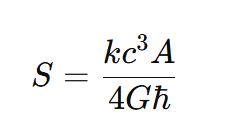The holographic principle is a revolutionary idea in theoretical physics that suggests all the information contained in a volume of space can be described by data on its boundary. In other words, the universe might be fundamentally a hologram, where a higher-dimensional reality is encoded on a lower-dimensional surface.
1. Origins of the Holographic Principle
The concept emerged from studies of black holes and string theory, particularly from the work of Gerard ‘t Hooft and Leonard Susskind in the 1990s. It was inspired by:- Bekenstein-Hawking Black Hole Entropy
- Jacob Bekenstein and Stephen Hawking showed that a black hole’s entropy (information content) is proportional to the area of its event horizon, not its volume:

- This suggests that all the information about objects that fall into a black hole is encoded on its surface rather than inside it.
- String Theory and AdS/CFT Correspondence
-
- In 1997, Juan Maldacena proposed the AdS/CFT duality, a mathematical realization of the holographic principle.
- It suggests that a higher-dimensional gravitational system (AdS space) is equivalent to a lower-dimensional quantum field theory (CFT) on its boundary.
2. Key Ideas of the Holographic Principle
- Information Storage on Boundaries: Just as a hologram encodes 3D images on a 2D surface, physical reality might be encoded on a lower-dimensional surface.
- Black Hole Information Encoding: Everything that falls into a black hole may be stored in quantum states on its horizon.
- Volume Redundancy: The bulk (3D or higher-dimensional space) is emergent and can be completely described by data on a lower-dimensional boundary.
3. AdS/CFT Correspondence: A Concrete Example
The AdS/CFT correspondence is the best example of the holographic principle in action:- Anti-de Sitter Space (AdS): A curved spacetime with an extra dimension.
- Conformal Field Theory (CFT): A quantum theory living on the boundary of AdS space.
- Duality: Physics in the bulk (gravity in AdS) is equivalent to quantum field theory on the lower-dimensional boundary.
- The 5D gravity theory in AdS space is mathematically identical to a 4D quantum field theory on its boundary.
- This means gravity and spacetime emerge from lower-dimensional quantum interactions.
4. Implications of the Holographic Principle
(A) Black Hole Information Problem
- If black hole information is encoded on its event horizon, then information might not be lost, resolving the information loss paradox.
- Hawking’s later ideas about soft hair on event horizons align with this view.
(B) Emergent Gravity and Spacetime
- Spacetime itself might be an emergent phenomenon arising from quantum interactions at the boundary.
- Some researchers propose that gravity is not a fundamental force but arises from quantum entanglement.
(C) The Universe as a Hologram
- If the holographic principle applies beyond black holes, our entire 3D universe could be a projection from a 2D boundary.
- Some cosmologists believe the universe’s information is encoded on the cosmic horizon.
5. Experimental Evidence and Challenges
- No direct experimental proof of the holographic principle exists, but certain quantum gravity calculations and black hole thermodynamics support it.
- Some quantum entanglement and holographic tensor network models provide further evidence.
- Tests involving holographic noise in quantum spacetime structures (e.g., Fermilab’s Holometer experiment) have not yet confirmed the idea.







